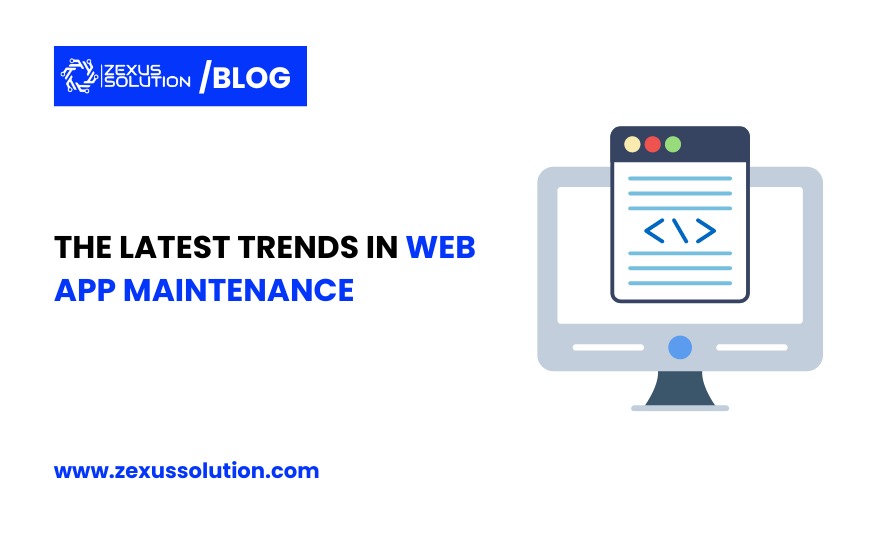Table of Contents
In today’s digital age, maintaining a strong online presence is crucial for your business. Your website serves as the front line for your brand or organization. But what happens if your site isn’t performing well? Will visitors return or trust a business with a mediocre website? The answer is no.
This is why regular website maintenance is essential. It ensures that your site remains authoritative, functional, and trustworthy. In this blog, we’ll delve into the latest trends in web app maintenance and explore how adopting these practices can be a vital digital strategy for your business. So, let’s get started!
Current Trends For Web Application Maintenance
Web maintenance trends have advanced significantly, yet many businesses still struggle to optimize their digital assets. This underlines the necessity of constant website updates and maintenance. However, businesses must know what they can do to improve the website experience first. Here are some of these trends and how they can be useful in enhancing user experience.
Emphasizing Security Updates

One of the most critical trends in web app maintenance is the emphasis on security updates. One of the key things to remember is that you have to update your web app frequently to fix security flaws. This encompasses updating the web server, the database, and any other components or libraries utilized in the development of the app.
Moreover, the use of proper security measures like; HTTPS and coming up with proper security monitoring can also assist in preventing any possible threat. Most of web app maintenance services involve security assessment and scan or vulnerability assessment to fix all the security loopholes that exist.
Performance Optimization
One of the many emerging trends in web app maintenance is guaranteeing the functionality of your web application. The users demand applications that are quick and highly responsive, and any delay results in a poor user experience and loss of customers. Optimization is a process of frequently checking the performance of an app and making changes when needed to make it faster and more efficient.
Coding optimizations like caching, code minification, and DB optimization are known to improve performance in modern web apps. Performance monitoring tools that capture metrics such as loading time, server response time, and resource utilization can be used to identify and resolve performance barriers.
Regular Backups

Losing data can severely damage any web application. Backups are among the most basic practices in web app maintenance because they allow you to easily restore your application in case data gets lost or corrupted. There are automated solutions for the regular backup of your application’s data, such as the database and the file system, to a secure location.
This is why it is always recommended to perform a backup and restore test to check how the data recovery procedures will work. This can be useful in cases where it becomes necessary to restore lost information, thus sparing time and money.
User Experience (UX) Enhancements
One of the key components of any web application is the user experience. Concerning the maintenance of web apps, it is worth noting that more recent trends revolve around the constant enhancement of the UX. Updating the interfaces of your application and making them more relevant to current trends and usability concepts can help boost user satisfaction.
One can use the feedback from the users and carry out usability testing to find out the areas of improvement. It makes the changes based on this feedback possible to improve the usability and make the experience for users a more pleasant one.
Mobile Responsiveness
With a rise in the use of mobile devices, there is a need to ensure that your web application is optimized for mobile devices. One of the most notable trends in web app maintenance is the optimization of applications for mobile devices. This includes the site layout and structure, optimization of images and media, and making sure all the features are mobile-friendly.
Mobile responsiveness enhances usability as well as has beneficial effects on your application’s rank in the search engine as the search engines prefer sites, which are mobile-friendly.
Automated Testing and Continuous Integration

Web app maintenance practices include automated testing, continuous integration, and continuous delivery. Automated testing means that the tests are run on your app through the use of tools so that new code changes do not have to be checked manually for bugs as well as regressions.
Continuous integration is a process that requires developers to frequently merge the code changes to the central repository and check for the bugs through the tests. Such activities can help save much time and efforts spent on the manual testing and make sure that your app is stable and safe. Jenkins, Travis CI and CircleCI are some of the commonly used tools to adopt CI solutions.
Scalability Considerations
As the number of users increases, the web app also has to expand to accommodate the new traffic. It is crucial to guarantee that your application is ready to take and handle more traffic and load without negatively impacting its performance and reliability.
Public cloud providers like Amazon Web Services, Microsoft Azure, and Google Cloud provide the flexibility of the infrastructure and services that can be adjusted based on the needs of an organization. Load balancing, horizontal scaling, and database sharding are the measures, which should be used to increase the scalability.
Monitoring and Analytics
Monitoring and analysis are crucial when you need to know how your web application responds to various conditions. These tools can measure the availability, response time, and error rates as various KPIs of the system. Users’ behavior can be analyzed through analytics tools, which can highlight popular features, usage patterns, and potential problems.
Thus, monitoring and analytics are critical components of the maintenance approach since they enable early identification of problems and decision-making for improvement of the application’s quality and efficiency for the end-user.
Regular Content Updates

Another important maintenance practice is updating the content of the web application regularly to ensure that it remains relevant. Periodically updated content also helps to attract users and contribute to the ranking of your site in search engines. This comprises of changing the text, images, videos, and any other content that may be on the site, creating new content and features.
WordPress, Joomla and Drupal are some of the CMS tools that assist in easy management of contents and frequent updating. It is also important to ensure that the CMS that you are using is updated with the latest security patches.
Accessibility Improvements
It is critical to guarantee that your web application is usable for all clients, including people with disabilities. The accessibility enhancements are the improvements of the features like the keyboard navigation, compatibility with the screen readers, and the alt tags for the images.
The use of web accessibility standards like the Web Content Accessibility Guidelines (WCAG) may assist in making your application accessible to a larger population. Periodic accessibility assessments help to recognize some of the shortcomings that your application might have.
Leveraging Artificial Intelligence and Machine Learning
Web maintenance is one of the most important aspects of web development and is being revolutionized by Artificial Intelligence (AI) and Machine Learning (ML). These technologies can help perform the regular maintenance tasks, identify possible problems, and adapt to the user’s preferences.
Machine learning can be used to analyze data based on the user’s behavior and performance indicators to detect potential issues before they occur. Some of the areas that benefit from machine learning are load balancing and resource allocation of your application.
Integration with Third-Party Services

Most modern web apps require third-party services to support different features like payments, newsletters, and social network integration. The other common aspect of maintenance is ensuring that these integrations are updated to meet the needs of the business.
Third-party APIs, libraries, and plugins should be reviewed and updated from time to time to conform to the application and security standards. Supervision of these services ensures that the performance and reliability of the services are not compromised hence preventing any interruption to users.
Conclusion
Keeping abreast with the latest trends in web app maintenance is important to maximize on the performance and sustainability of the web applications. If you focus on security updates, performance, regular data backup, and the constant enhancement of the app’s UX, you can maintain the stability of your app and its protection.
Embracing automated testing, scalability considerations, monitoring, and analytics allows you to proactively address issues and make data-driven decisions. Regular content updates, accessibility improvements, compliance with regulations, and environmental considerations help maintain a positive user experience and build trust with your audience.



Add a Comment